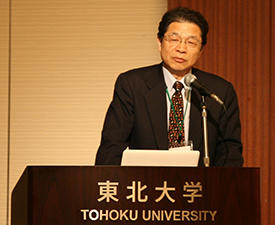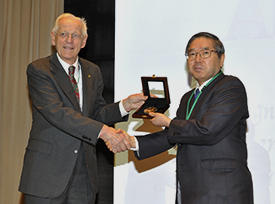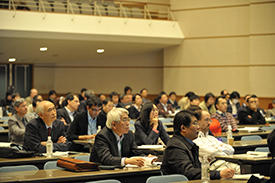

04/26/2010
The WPI-AIMR Annual Workshop is a key date in the yearly calendar of the World Premier International Research Center - Advanced Institute for Materials Research (WPI-AIMR) when the members of the center join together with other notable researchers from around the globe to discuss the latest developments in materials science, exchange information and ideas, and look towards the future.

The 2010 Annual Workshop — the third in the series — was held from March 25 in the city of Sendai in Japan’s northerly Miyagi prefecture — the base of the WPI-AIMR. The 2010 meeting was attended by more than 220 researchers from 17 countries, including many senior and internationally renowned materials scientists from Asia, Oceania, Europe and North America, who braved the unseasonably low temperatures to engage in three days of wide-ranging discussion and debate.
In his welcoming address, WPI-AIMR Director Yoshinori Yamamoto encouraged all participants to attend as many different sessions as possible over the duration of the workshop. He also pointed out that the guiding principle of the WPI-AIMR is ‘fusion research’, and that the organization of the lecture program into several parallel sessions dealing with a mixture of topics including bulk metallic glasses, nanophysics, nanochembio and devices & systems was a conscious effort by the organizers to reflect the center’s mission and encourage cross-disciplinary thinking.
The wide variety of parallel sessions were designed to supplement a program of 18 plenary talks given by leading international materials science researchers, including WPI-AIMR members based at institutions outside Japan. In addition, the poster session held on the afternoon of Friday March 26 drew close to 80 poster presentations on a wide variety of topics that were the subject of vigorous debate among the participants.

The workshop also witnessed the presentation of the 2010 Acta Materialia Gold Medal to Akihisa Inoue, president of Tohoku University and an International Advisory Board member at the WPI-AIMR. First awarded in 1974, the prize is given annually by Acta Materialia Inc. to honor a researcher who has made a contribution of particular merit to materials science. Inoue is only the third Japanese researcher to receive the award, and the second from Tohoku University. The award, which was made in recognition of Inoue’s pioneering work on bulk metallic glasses and outstanding achievements and leadership in materials science, was presented by Ted B. Massalski (Carnegie Mellon University), the Executive Secretary of Acta Materialia, at a ceremony in the Sendai International Center.
One of the focal points of the workshop was a special Nobel Laureate Lecture in which Georg Bednorz, who was awarded the 1987 Nobel Prize for Physics for his work on high-temperature superconductivity, gave a wide-ranging talk on the topic of ‘Exploring the Nanotechnology Landscape’, drawing on his work at the IBM Zurich Research Laboratory. Speaking to AIMResearch, Bednorz, a member of the WPI-AIMR International Advisory Committee, praised the work of the center: “Last year I attended the [WPI-AIMR] workshop and I found the activities here to be quite amazing,” he said, particularly noting that the work of the center encompasses “quite a broad spectrum of activities.” Bednorz also described the fusion research approach as being “very important” and praised the WPI-AIMR policy of giving young researchers a free hand in directing their research. “I think it’s important that young people take the initiative … they get financial support and take over a common project. I think this is important,” he said.

Yamamoto also spoke to AIMResearch about the importance of fusion research, and confirmed his commitment to keep it at the heart of the scientific activities of the center. “The WPI-AIMR is now in its third year, and we feel that we have finally established the right organizational and research structure that will allow us to go forward,” he said. “We have already made a number of interesting discoveries and now we can accelerate the pace of delivery. The concept of fusion research will be critical in realizing this goal.”
Himself a longstanding proponent of increased participation of overseas researchers in Japanese institutions, Yamamoto commented favorably on the international diversity of the workshop. This is reflected in the makeup of the WPI-AIMR personnel, in which one-third of the academic staff and almost two-thirds of the research associates are non-Japanese, a fact that Yamamoto identified as being one of the key strengths of the center. This success is a result of a conscious and sustained policy of proactively recruiting talented young researchers from overseas to work alongside Japanese counterparts, he noted. “We are now in the happy position of actually getting unsolicited enquiries from young foreign scientists asking us about research opportunities at the WPI-AIMR,” commented Yamamoto. “We expect that in the near future, young people from all over the world will come to see the WPI-AIMR as a natural choice for advancing their research career in materials science.”
The very high level of science on display at the 2010 WPI-AIMR Annual Workshop and the obvious enthusiasm of the many young international participants would seem to suggest that this ambition may well be realized sooner rather than later.